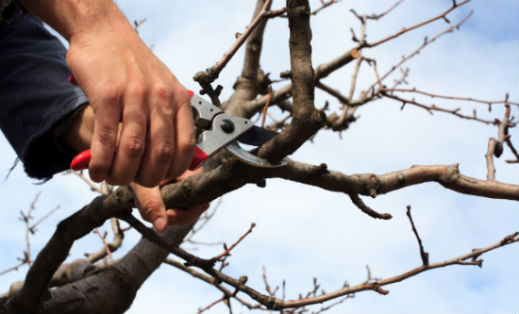
About Tree Pruning
For many people, pruning trees can be an arduous and frightful endeavor. With some easy reading, pruning can be a straightforward and even enjoyable experience. If you are wondering any of the following questions, this guide may help you.
When is the right time to prune? How often should you prune? What parts of a tree should not be pruned? How can I minimize damage to the tree? How do I keep myself safe? How do I take care of my pruning equipment?
Why Should You Prune?
Some people desire to prune their trees to maintain the aesthetic of their home, apartment, or building. However, pruning your trees does more than help your trees look neat and attractive; it helps your trees grow strong and upright. It is important to prune correctly and at the correct times to ensure you do not damage the tree.
When is the Best Time to Prune?
Light pruning of dead wood, infected branches, and inconvenient protrusions can be done at practically any time of the year.
Annual/Seasonal pruning. Individual species may vary in how often they should be pruned. Be sure to research the specific tree you have, as it may require specific techniques. More generally, here are some guidelines.
The most common practice of pruning trees is pruning during dormancy in the later winter months (after the coldest parts). Doing so results in an energetic burst of growth and development of the tree in the spring.
Pruning during the summer is another common practice used to direct and control the growth of trees. Trimming away small branches that you do not want should be done soon after seasonal growth is complete, usually towards the end of summer.
When Should You NOT Prune?
Wood-decay fungi commonly spread their spores during the fall and can affect trees whose interior is exposed, so pruning in between summer and winter should be avoided.
General Tips for Good Pruning
- No more than ¼ of the crown of a tree (the leafy area) should be removed in a season
- To get a clean cut, cut on the underside of the branch. This reduces the chance of a branch “cracking” or “bending” off due to gravity and prevents unclean cuts
- To ensure safe upright growth, each main side branch should be less than 2/3 the size of the main branch
- Encourage side branches that grow at upward angles
- Protecting pruning cuts will not be necessary if the pruning was done in the late winter or mid-to-late summer
- For larger branches, cut outside the branch bark and ridge collar (after the branch swell). Do not leave a protruding stub
- When shortening a small branch, cut at a lateral bud or branch. Make a sharp and clean cut at a very slight angle
Maintaining Equipment and Staying Safe
Tree pruners/clippers/tools should always be cleaned before and after use, especially if you remove cankers or diseased tree segments. To disinfect your tools, use rubbing alcohol or another household cleaner to prevent the spreading of disease. Sharpen the blades using a sanding stone or rock.
Always have another individual with you when pruning and use strong gloves. Make sure no one is below the branch you are cutting.
Miles Lefler, is a certifed staff arborist and an Oak Wilt Specialist. He diagonoses and treats a variety of different trees. He also helps navigate clients through the process of recieving permits for tree removal.
